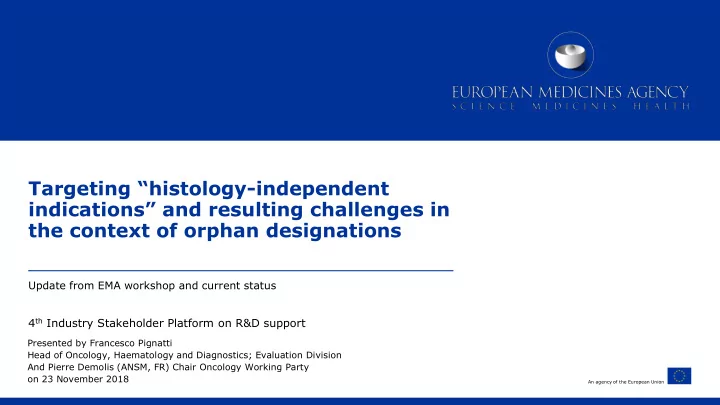

Targeting “histology -independent indications” and resulting challenges in the context of orphan designations Update from EMA workshop and current status 4 th Industry Stakeholder Platform on R&D support Presented by Francesco Pignatti Head of Oncology, Haematology and Diagnostics; Evaluation Division And Pierre Demolis (ANSM, FR) Chair Oncology Working Party on 23 November 2018 An agency of the European Union
Markers and Drivers Oncogenic process or survival pathway (resistance) : efficient malignant cell (clone) Marker = biological revelator N Driver = chain of events leading to malignancy M Normal cell K D 1
Markers and Drivers Examples Survival or oncogenic pathway : double BRCAm Marker = Germinal mutation or somatic mutation, or platinum sensitivity. Driver = DNA repair deficiency M D K 2
Easy story One marker detects One driver Sensitivity to one specific therapeutic approach Let’s use that therapeutic approach As soon as a tumour expresses the marker Histology, anatomy, age, line do not matter any longer IN OTHER TERMS : THE MARKER IS THE BEST (the only relevant) PREDICTOR OF SUCCESS 3
The story is not always that simple Multiple drivers (BRAFm and colorectal cancer) New drivers (loss of Pt sensitivity) Tumour heterogeneity (within tumours, between sites) Proof of concept Importance of non-clinical models 4
Should (could) we keep all fruits ? Rare cancers Prognosis ? Comparative data ? Extrapolations ? across diseases across lines across ages Extrapolation starting point ? 5
The concept of histology-independent indications Requires in-depth knowledge about the mechanism of and at • least strong plausibility across subgroups; Need to explore heterogeneity of effects (interactions; resistance • mechanisms) ; Multiple therapeutic contexts, evidence of positive benefit-risk • balance Easier when high unmet need across subgroups • Challenging when competing against available options with established • clinical utility (e.g. survival) in some subgroups; indirect comparisons (rare diseases; lack of historical data);extrapolation 6
The concept of histology-independent indications : some limits ‘ Orphanization ’: one unique marker artificially selected to justify ultra - • orphan development despite the drug (or the marker) not being that specific of the driver/disease. Is the medical need the same across indications ? • e.g., colorectal cancer, first line, established treatments with OS benefit • 7
Current status • In principle, no regulatory or scientific objection to histology- independent indications. Already contemplated in the anticancer guideline • • In practice though, the concept is challenging Lack of successful examples of marketing authorisation • applications in the EU but experience growing in scientific advice • Reflections ongoing at the level of oncology and biostatistics working parties, possible guidance to be drafted 8
Recommend
More recommend